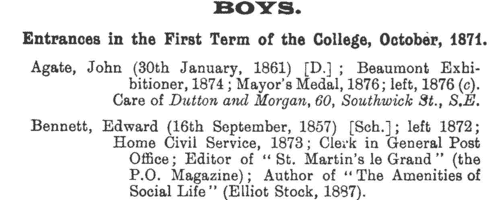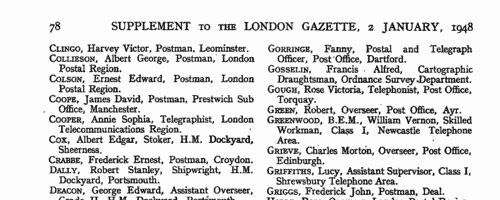Etherington Surname Ancestry ResultsOur indexes 1000-1999 include entries for the spelling 'etherington'. In the period you have requested, we have the following 357 records (displaying 51 to 60): Single Surname Subscription | | | Buying all 357 results of this search individually would cost £2,074.00. But you can have free access to all 357 records for a year, to view, to save and print, for £100. Save £1,974.00. More... |
These sample scans are from the original record. You will get scans of the full pages or articles where the surname you searched for has been found. Your web browser may prevent the sample windows from opening; in this case please change your browser settings to allow pop-up windows from this site. Boys entering Dover College
(1873)
The second edition of the Dover College Register, edited by William Stevens Lee, lists all boys entering the school from its opening in 1871 to the date of publication in 1899. The boys are listed alphabetically by term of entry, surname and full christian names. A double dagger after the name indicates a school prefect. Next comes the year or date of birth, then abbreviations indicating house - [D] day boy; [Sch.] School House; [Sp.] Sparke's House; [St.] Steedman's House; [W.] Walters' from 1881 to 1886, Williams' from 2nd term 1890 to 3rd term 1898; [L.] Littlewood's (the same house as Walters') fom 3rd term 1886 to 1st term 1890. From 3rd term of 1892 onwards the names were changed to [S.] School House; [P.] Priory House (was Sparke's); [M.] St Martin's (was Williams'). Moreover, in January 1893 the Junior School was established at West Mount, and from then onwards [J] indicates a period there. Next come distinctions gained in the school, exhibitions, &c., and athletic distinctions, such as XI for membership of the school cricket eleven, XV for the school football team, with years; then date of leaving; distinctions gained since leaving; and present address (where known) as of 1899. Despite this attempt at comprehensive coverage, the materials to hand for compiling the register were often lacking: at worst, in the early years, there are a handful of entries where only the surname is given. Equally, other entries are detailed and comprehensive. ETHERINGTON. Cost: £4.00.  | Sample scan, click to enlarge

| Civil Service Appointments
(1860)
The Civil Service Commission published an annual list of all persons who had obtained certificates of qualification for appointment in the various public departments. The list gives full name (surname first); department (such as Post Office, or Inland Revenue); situation (such as Letter-carrier, or Clerk); and date of certificate. Candidates whose names are preceded by a dagger obtained appointments as the result of competition; a double dagger indicates open competition. Those whose names are preceded by an asterisk obtained honorary additions to their certificates either for proficiency in extra subjects chosen by themselves, or for marked proficiency in the prescribed subjects. Then follows a further list of these candidates who had obtained Honorary Additions to their Certificates in this way: giving name (surname and initials); position in the service (department and situation); subjects for which honorary additions were made; and 'extent of knowledge displayed' (such as Creditable, Fair, or Very Creditable). 1 January to 31 December 1860.ETHERINGTON. Cost: £4.00.  | Sample scan, click to enlarge

| Imperial Service Medal
(1947)
The Central Chancery of the Orders of Knighthood at St James's Palace announced these awards by king George VI of the Imperial Service Medal to members of the Home Civil Service. The names are arranged alphabetically by surname (in capitals) and christian names, with office or rank in the service.ETHERINGTON. Cost: £4.00.  | Sample scan, click to enlarge

| Stockton-on-Tees Voters: Thornaby Polling District
(1868)
This poll book for the First Parliamentary Election for the Borough of Stockton-on-Tees lists the voters alphabetically by polling district, with full name (surname first) and address. In the right-hand column D represents the Liberal candidate, Joseph Dodds, Esq., and V the Conservative, Lord Ernest Vane Tempest. The three polling districts were Norton, Stockton (including so much of Linthorpe as lay within the parliamentary borough of Stockton), and Thurnaby. At the end of each district the handful of lodger voters are listed separately.ETHERINGTON. Cost: £4.00.  | Sample scan, click to enlarge

| South County Durham Poll Book: Barnard Castle District
(1832)
A poll for two Knights of the Shire to represent in Parliament the Southern Division of the county palatine of Durham was taken on 21 and 22 December 1832. This poll book sets out all the electors by polling district (Barnard Castle, Bishop Auckland, Darlington, Middleton-in-Teesdale, Sedgefield, Stanhope and Stockton) and gives registered number; full name (surname first); place of abode; nature of qualification (such as House as occupier, Land as occupier, Copyhold Property, &c.); and the name of the parish, township or place where the property is situate. The votes are set out in the right-hand columns, under P. (for Joseph Pearse, jun., esq.), B. (John Bowes, esq.), and S. (Robert Duncombe Shafto, esq.), the three candidates. A voter could choose two candidates, in which case a dash is put in each of the two appropriate columns, or plump for just one - where a star is placed in that candidate's column. This was the first election after the Reform Act, which extended the franchise in the counties to all adult men possessing freehold worth 40s a year or more, or copyhold or long leasehold of £10 or more, or being tenants or short leaseholders of £50 or more. ETHERINGTON. Cost: £4.00.  | Sample scan, click to enlarge

| South County Durham Poll Book: Darlington District
(1832)
A poll for two Knights of the Shire to represent in Parliament the Southern Division of the county palatine of Durham was taken on 21 and 22 December 1832. This poll book sets out all the electors by polling district (Barnard Castle, Bishop Auckland, Darlington, Middleton-in-Teesdale, Sedgefield, Stanhope and Stockton) and gives registered number; full name (surname first); place of abode; nature of qualification (such as House as occupier, Land as occupier, Copyhold Property, &c.); and the name of the parish, township or place where the property is situate. The votes are set out in the right-hand columns, under P. (for Joseph Pearse, jun., esq.), B. (John Bowes, esq.), and S. (Robert Duncombe Shafto, esq.), the three candidates. A voter could choose two candidates, in which case a dash is put in each of the two appropriate columns, or plump for just one - where a star is placed in that candidate's column. This was the first election after the Reform Act, which extended the franchise in the counties to all adult men possessing freehold worth 40s a year or more, or copyhold or long leasehold of £10 or more, or being tenants or short leaseholders of £50 or more. ETHERINGTON. Cost: £4.00.  | Sample scan, click to enlarge

| South County Durham Poll Book: Stockton District
(1832)
A poll for two Knights of the Shire to represent in Parliament the Southern Division of the county palatine of Durham was taken on 21 and 22 December 1832. This poll book sets out all the electors by polling district (Barnard Castle, Bishop Auckland, Darlington, Middleton-in-Teesdale, Sedgefield, Stanhope and Stockton) and gives registered number; full name (surname first); place of abode; nature of qualification (such as House as occupier, Land as occupier, Copyhold Property, &c.); and the name of the parish, township or place where the property is situate. The votes are set out in the right-hand columns, under P. (for Joseph Pearse, jun., esq.), B. (John Bowes, esq.), and S. (Robert Duncombe Shafto, esq.), the three candidates. A voter could choose two candidates, in which case a dash is put in each of the two appropriate columns, or plump for just one - where a star is placed in that candidate's column. This was the first election after the Reform Act, which extended the franchise in the counties to all adult men possessing freehold worth 40s a year or more, or copyhold or long leasehold of £10 or more, or being tenants or short leaseholders of £50 or more. ETHERINGTON. Cost: £4.00.  | Sample scan, click to enlarge

| Students at the London School of Economics
(1905-1906)
An alphabetical list of students attending the London School of Economics during the academic year 1905-1906: the list gives surnames and initials. Women students are distinguished by an asterisk. A superscript 1 indicates that the student has passed one of the Oxford Honours Schools examinations; a superscript 2 that he or she has passed one of the Cambridge Triposes.
ETHERINGTON. Cost: £4.00.  | Sample scan, click to enlarge

| Chemists and Druggists
(1919)
The official register printed under the direction of the Pharmaceutical Society of Great Britain pursuant to the act of 31 & 32 Victoriae, cap. 121 (An Act to Regulate the Sale of Poisons, and Alter and Amend the Pharmacy Act, 1852) comprised two sections:
1.The Register of Pharmaceutical Chemists, giving date of registration, number of examination certificate, full name (surname first, in capitals), and residence;
2. The Register of Chemists and Druggists, giving date of registration, full name (surname first, in capitals), residence, number of examination certificate (major or minor), and qualification.ETHERINGTON. Cost: £4.00.  | Sample scan, click to enlarge

| York Will Calendar
(1660-1665)
The diocese of York comprised most of Yorkshire, and Nottinghamshire: the York Exchequer court was the ordinary probate jurisdiction for the Yorkshire part of the diocese, but some wills from Nottinghamshire and other parts of the province of York were also proved there. Dr Francis Collins compiled this index to the wills in the York registry proved from 1660 to 1665. The date of the probate precedes the name of the testator: during the period covered by the volume the dates of probate are very rarely given in the registers - they were therefore supplied from the Act Books. However, the Act Book for Ainsty, City and Craven deaneries is missing for this period, and in those cases no date could be given. In a very few instances (marked with an asterisk) in these deaneries in which the date has been supplied it has been taken from the registers. Additional matter from the Act Books is given within square brackets. Testators' names are given in full, surname first; then parish or place of abode, and in some cases occupation; then date of the will itself; and volume and folio number in the probate register. Where a place of burial, or intended burial, was indicated, that is also added, with the word 'bur.', within round brackets. All wills between 1652 and 1660 were proved in London; in practice, many Yorkshire wills had remained unproved at the date that the York Exchequer probate court was restored, and so there is in this list a large number of wills dating back through the 1650s.ETHERINGTON. Cost: £2.00.  | Sample scan, click to enlarge

|
Research your ancestry, family history, genealogy and one-name study by direct access to original records and archives indexed by surname.
|












